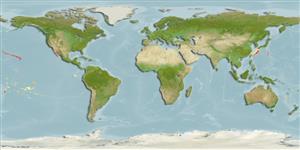>
Eupercaria/misc (Various families in series Eupercaria) >
Priacanthidae (Bigeyes or catalufas)
Etymology: Priacanthus: Greek, prion = saw + Greek, akantha = thorn (Ref. 45335).
Eponymy: Seth Eugene Meek (1859–1914) was an ichthyologist at the Field Museum of Natural History in Chicago. [...] (Ref. 128868), visit book page.
Environment: milieu / climate zone / depth range / distribution range
Ökologie
seewasser riff-verbunden; standorttreu; tiefenbereich 3 - 230 m (Ref. 38732). Tropical
Eastern Pacific: Hawaiian and Midway Islands; a single juvenile specimen recorded from the Galapagos Islands. Strays reach Johnston Atoll (Ref. 9710). Reports from Japan are probably misidentifications of Priacanthus hamrur.
Size / Gewicht / Alter
Maturity: Lm ? range ? - ? cm
Max length : 33.0 cm TL Männchen/unbestimmt; (Ref. 9710)
Inhabit clear lagoon and seaward reefs. Found under ledges during the day (Ref. 9710). Benthopelagic (Ref. 58302). Spawning may occur by December or soon after. Sound production has been studied in this species (Ref. 5403).
Life cycle and mating behavior
Geschlechtsreife | Fortpflanzung | Ablaichen | Eier | Fecundity | Larven
Starnes, W.C., 1988. Revision, phylogeny and biogeographic comments on the circumtropical marine percoid fish family Priacanthidae. Bull. Mar. Sci. 43(2):117-203. (Ref. 5403)
IUCN Rote Liste Status (Ref. 130435: Version 2024-1)
Bedrohung für Menschen
Harmless
Nutzung durch Menschen
Fischereien: kleinfischerei; Aquarium: Kommerziell
Tools
Zusatzinformationen
Download XML
Internet Quellen
Estimates based on models
Preferred temperature (Ref.
123201): 18.7 - 23.1, mean 20.8 °C (based on 10 cells).
Phylogenetic diversity index (Ref.
82804): PD
50 = 0.5002 [Uniqueness, from 0.5 = low to 2.0 = high].
Bayesian length-weight: a=0.01698 (0.00734 - 0.03932), b=2.91 (2.72 - 3.10), in cm total length, based on LWR estimates for this (Sub)family-body shape (Ref.
93245).
Trophic level (Ref.
69278): 4.2 ±0.73 se; based on food items.
Widerstandsfähigkeit (Ref.
120179): hoch, Verdopplung der Population dauert weniger als 15 Monate. (Preliminary K or Fecundity.).
Fishing Vulnerability (Ref.
59153): Low vulnerability (23 of 100).
Nutrients (Ref.
124155): Calcium = 53.3 [34.5, 83.5] mg/100g; Iron = 0.729 [0.464, 1.097] mg/100g; Protein = 19.3 [18.2, 20.2] %; Omega3 = 0.185 [0.121, 0.280] g/100g; Selenium = 43.7 [26.0, 76.3] μg/100g; VitaminA = 105 [45, 255] μg/100g; Zinc = 0.942 [0.676, 1.292] mg/100g (wet weight);
